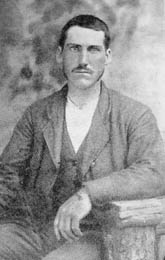Daniel VanBuren Moody: Civil War Casualty From a Pickens Pioneer Family

By Dr. Thomas Cloer, Jr.
Special to The Courier
Introduction
My mom is Grace Moody Cloer. She celebrated her 90th birthday on Veterans Day 2014. Daniel VanBuren Moody was my great-great maternal grandfather, who was born in Pickens District on Aug. 18, 1838. His family, like so many families during the Civil War, was split over the ideology of that turbulent time.
The very name, Daniel VanBuren Moody, reflects something about the political nuances involved. His father’s name, Martin Moody, was also given in honor of the politician and President Martin Van Buren, who was president of the United States from 1837-1841. Daniel VanBuren Moody was also a namesake of his grandfather, whom I’ll call Papa Daniel. Papa Daniel was my great-great-great-great-grandfather of the old Pickens District. But, why would Papa Daniel Moody and his son, Martin, in Pickens District, S.C., become so influenced by a politician such as Martin Van Buren from the state of New York?
Martin Van Buren: The President
Martin Van Buren was the first president not to be born as a British subject under British rule. He was called “The Little Magician” in politics. He was short in stature and very adroit as a politician. He knew how to keep down the number of his enemies. He is largely responsible for our modern two-party system of politics. He is also credited as the founder of the nominating convention for political parties. He knew the value of compromise. He toured South Carolina in 1827. (I always wondered if Papa Daniel had seen and heard him.) He was elected to the New York State Senate in 1812 and the U.S. Senate from New York in 1821. He was elected governor of New York in 1829, vice president of the U.S. in 1832 and president of the U.S in 1837. Van Buren was the last vice president to be elected directly to the presidency until George H.W. Bush in 1988, 151 years later.
While Van Buren was good at compromise, he also knew how to spin. I believe Papa Daniel was influenced by the president’s stated opposition to the expansion of slavery. Van Buren believed that slavery was morally wrong. He was opposed to any expansion of slavery. He voted against the annexation of Texas, which would add significantly to slave territory. However, later in his political career, he said that while he considered slavery morally wrong, it was probably justified constitutionally in the U.S. Van Buren was again the nominee for president of the U.S. by the Free Soil Party in 1848, but he lost. This party’s stated purpose was opposing the expansion of slavery. “Free men on free soil comprised a morally and economically superior system to slavery.” There is little doubt that my ancestors, dating far back in the old Pickens District, were influenced by our eighth president, “The Little Magician.”
The Moodys of Tamassee
In the 1800s, prior to the Civil War, Papa Daniel owned much farmland on the Toxaway, Crow Creek, Keowee, and Little River of Pickens District, but had no slaves. About the time Daniel VanBuren Moody was born, there were 2,715 black people who had been bought and were enslaved in the Pickens District; slavery was expanding rapidly. In 10 years, the number had more than doubled in the district to 5,808 slaves in 1850.
Papa Daniel was born in 1779, shortly after the Declaration of Independence was signed, and came to the Pickens District as a young man. He served on the first grand jury of the old Pickens District. I remember they sentenced a man to a whipping for stealing an ax. Papa Daniel is buried in the old Wolfpit Cemetery at the Cheohee Community Center inTamassee. He was a neighbor of Andrew Pickens. The Moodys were charter members of Cheohee Baptist Church. .Martin Moody, Papa Daniel’s son, was a minister and pastor at Cheohee Baptist Church, near Tamassee, which is now in Oconee County. The old Pickens District split into Pickens and Oconee counties in 1868. Martin’s brother, Bennett Moody, was also pastor there during the 1840s, 1850s and 1869-1870.
In Kay Alexander’s History of Cheohee Baptist Church, she described the church in the 1860s.
“The men sat on one side of the church, where there was a one-foot wide space, never completed, through which the older men spat tobacco juice. The women sat on the opposite side. A water bucket with a dipper was placed near the pulpit, from which the pastor drank and mothers brought their children all during the service.” Alexander described the church as “A one-room frame building…it contained plank benches, kerosene wall lamps with a piece of tin behind each for reflection, and a large stove.” In 1886, 50 years after my great-great-great-grandfather Martin Moody was pastor, the pastor’s salary for Cheohee was listed in the associational minutes as $8 per year.
My great-great-great-grandfather Martin Moody and his wife, Lucinda Nicholson Moody, had seven girls and five boys. My great-great-grandfather Daniel VanBuren Moody, who fought in the Civil War, was born in 1838, a year his daddy, Martin, pastored Cheohee Baptist Church at Tamassee.
Family Problems
I first learned of the family problems when I read Martin Moody’s last will in very old Pickens records. Martin, the minister, wrote his son, Daniel VanBuren Moody, out of the will on Dec. 28, 1857. They obviously had differing views about the troubling times. Martin wrote that Daniel “left home early without just cause.” Daniel never reconciled and had a difficult time with family for the rest of his life. I must say that if Martin wanted to change his son’s thinking, excoriating him in the will was probably not the same strategy I would have recommended.
Daniel left Pickens and moved to the Tuckasegee Valley in Jackson County, N.C., where my mom, his great-granddaughter, was born there on his farm. There in Jackson County, May 31, 1861, he enlisted in Company B of the 25th Regiment of the North Carolina State Troops, Confederate States of America. He preferred to be called Dan Moody. This group was formerly called the North Carolina 15th Volunteers. He married Nancy Ann Slatton in 1862. His first son, my great-grandfather John Thomas Moody, was born Jan. 23, 1863.
Serious Injury at
Battle of Marye’s Heights, Fredericksburg, Va.
Dan V. Moody was part of Ransom’s Brigade led by Brigadier General Robert Ransom Jr. Ransom’s Brigade helped to successfully defend Marye’s (pronounced “Marie’s” not Mary’s) Heights against the attacking Federals at Fredericksburg, Va. Dan was seriously injured on Dec. 13, 1862, in this most one-sided battle of the Civil War. Union casualties under General Ambrose Burnside were more than twice those of the Confederates led by Robert E. Lee.
On Dec. 13, the Division of Major General William B. Franklin of the Union was able to pierce the first defensive line of Confederate Lieutenant General Stonewall Jackson. However, the frontal attacks on Marye’s Heights by the Union Generals Edwin Sumner and Joseph Hooker were totally futile. It was here that Dan’s 25th Regiment was in battle at Marye’s Heights. His Confederate infantry used a huge stone wall as a barricade in the historic Sunken Road at the base of Marye’s Heights. The Confederate artillery on the high ground, facing in the same direction as the infantry behind the stone wall, fired safely over the heads of their Confederate comrades at the base of Marye’s Heights.
General James Longstreet’s position on Marye’s Heights was devastating to Union Troops. If the Union soldiers survived the artillery blasts and pushed forward, they encountered the impenetrable Confederate infantry behind the stone wall. In one hour, 3,000 Union soldiers were lost, but the horrific slaughter continued. Longstreet reported to Robert E. Lee that if he could be supplied with enough ammunition, he could defeat the whole Union Army right there if they kept up their inept tactics out in the open in front of the wall. Here was the opposite situation of that which occurred later at Gettysburg, Pa. There the Union Army held the high ground, Big Round Top and Little Round Top. There, at Gettysburg, the Confederates were exposed, out in the open, and on the losing end.
Fredericksburg was one of the largest (172,504 forces engaged) and deadliest battles of the Civil War. The Union Army had 12,653 casualties, with 1,234 killed, 9,600 wounded, and the remainder captured or missing. The Confederacy suffered 5,377 casualties, with 608 killed, 4,116 wounded, and 653 captured or missing. Dan V. Moody and 87 other members of his 25th North Carolina Regiment were included in the casualty count. The result was a resounding victory for the Confederacy. I’m not sure what type of round hit my great-great-grandfather. I think it might have been the Ketchum hand grenade patented the previous year and used by the Union Army. It came in 1-, 3- and 5-pound varieties. They were thrown like darts and had to land head-first to explode.
Dan explained his injury thusly: “A shell was thrown by the enemy and busted nearby. One piece of the shell, about one quarter of an inch square, went into left shoulder, and lies right against the joint at present and bothers me very much. … Elbow joint was also badly wounded and hurts very much. Wrist was broken all to pieces and never was straightened and is very much painful.” He was given a furlough for six months. He then tried to return to service, but was not able to use his left arm. He was discharged because of his disability just as the Battle of Gettysburg spelled the beginning of the end for the Confederacy.
Life After War
Daniel V. Moody and Nancy Slatton Moody had 11 children from 1863-1888. The marriage was a difficult one at best and very troubled at its worst. The 1870 U.S. Federal Census showed Daniel V. and Nancy Moody with four children. Daniel V. was 32 years old. By 1880, he had fathered five more children with Nancy. The 1880 census, however, found Daniel V. Moody in Callahan, Texas, 42 years old, where he listed himself as “single.”
Frank Moody, 96, Mom’s first cousin who still has a home very near the old Moody farm on the Tuckasegee River in Jackson County, N.C., showed me where Daniel V’s wife, Nancy Slatton Moody, was buried at the Tuckasegee Baptist Church Cemetery. When I asked about Daniel V.’s gravesite, Frank told me he believed Daniel V. went west (which he had) after telling everyone he was “going to sharpen an ax.” He must have successfully sharpened his ax, because he returned to father two more children with Nancy in the 1880s.
Dan V. returned from the west. In 1885, he married Caroline Brown Mangold, in Hiawassee, Ga., ostensibly without divorcing Nancy. I have a copy of the Georgia marriage certificate. His last child with Nancy was born on July 30, 1888 (It ain’t that far from Hiawassee to Tuckasegee.) In the federal 1890 census, Daniel V. was still with Caroline Moody. By 1910, he and Caroline had moved to mountainous Habersham County, Ga. Dan V. Moody was then in his 70s.
I have copies of the documents, where as a widow of Daniel VanBuren Moody, Nancy Slatton Moody, mother of his 11 children, on May 21, 1919, applied for a pension under “An act … for the relief of certain Confederate Soldiers, Sailors, and Widows … and proofs filed in support thereof … Nancy Moody is the widow of the late Dan Moody, who enlisted in Company B, 25th Regiment, North Carolina State Troops, 1861 … to serve in the armies of the Confederate States. She further states … that she is now a widow.” This was signed by the Clerk of the Superior Court, Jackson County, N.C.
The troubled life of Daniel VanBuren Moody, who left home early as a young man from the old Pickens District in South Carolina and later joined the Confederacy to fight and obtain a life-changing injury near Marye’s Heights in Fredericksburg, Va., was now at rest. The errant, wayward son decided early in his stressful life to march to the fife and drum of the Confederacy. Each year, on the first Saturday in June, we gather together at the Moody Reunion to celebrate our ancestry, troubled lives and all.
Thomas Cloer Jr. is a Professor Emeritus at Furman University. He was the first South Carolina Professor of the Year, being chosen by the late Gov. Carroll Campbell and The South Carolina Commission on Higher Education.



























